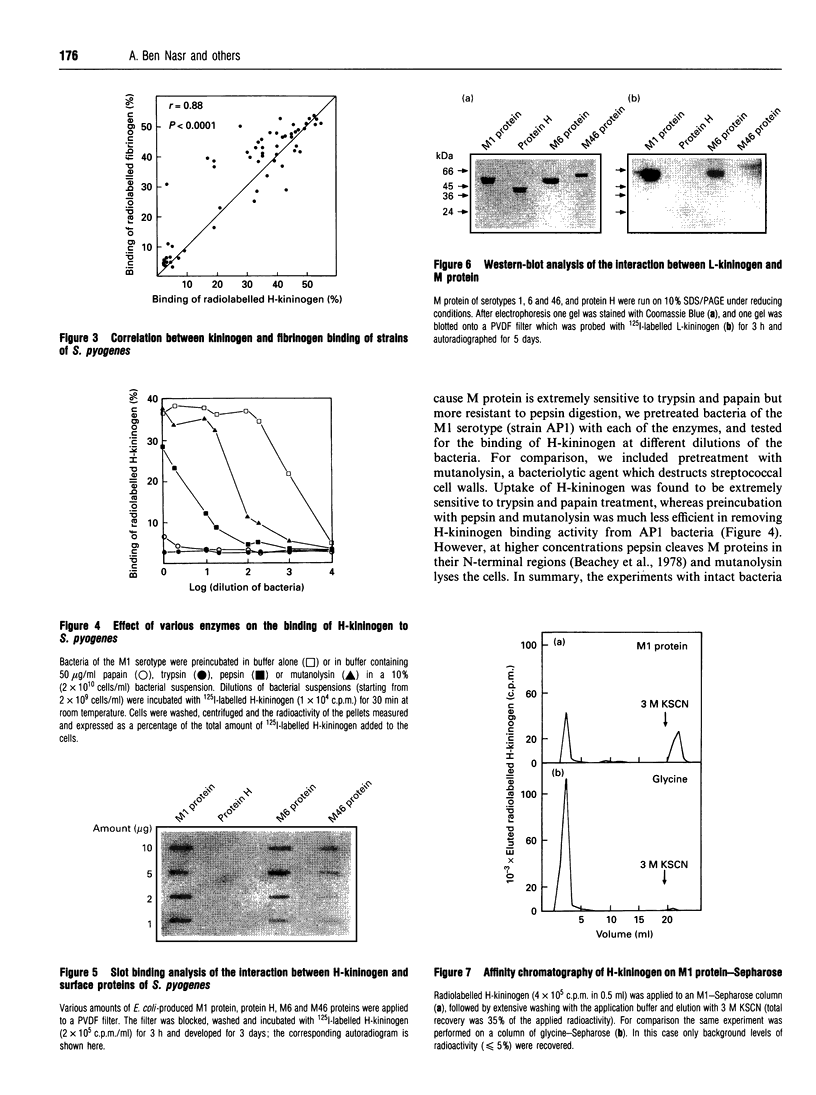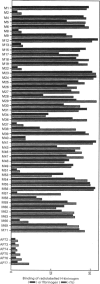Abstract
Streptococcus pyogenes, the most significant streptococcal species in clinical medicine, expresses surface proteins with affinity for several human plasma proteins. Here we report that kininogens, the precursors to the vasoactive kinins, bind to the surface of S. pyogenes. M protein, a surface molecule and a major virulence factor-in these bacteria, occurs in > 80 different serotypes. Among 49 strains of S. pyogenes, all of different M serotypes, 41 bound radiolabelled kininogens, whereas 6 M protein-negative mutant strains showed no affinity. M protein of most serotypes bind fibrinogen, and among the 55 strains tested, binding of kininogens was closely correlated to fibrinogen binding (r = 0.88, P < 0.0001). Western blotting, slot binding and enzyme immunoassay experiments demonstrated that M proteins isolated from S. pyogenes of three different M protein serotypes (M1, M6 and M46) bound kininogens. The affinity between kininogens and M1 protein was determined to be 5 x 10(7) M-1 and < or = 10(6) M-1 for high molecular weight (H-kininogen) and low molecular weight kininogen, respectively. The kininogen binding site was tentatively mapped to the N-terminal portion of M1 protein, and this site does not overlap the specific and separate binding sites for albumin, IgG and fibrinogen using monoclonal antibodies to, and synthetic peptides of, the kininogen sequence, the major M protein-binding site(s) was mapped to the C-terminal portion of the H-kininogen light chain. We anticipate that the kininogen-M protein interaction contributes to the host-parasite relationship in S. pyogenes infections.
Full text
PDF







Images in this article
Selected References
These references are in PubMed. This may not be the complete list of references from this article.
- Akerström B., Björck L. Protein L: an immunoglobulin light chain-binding bacterial protein. Characterization of binding and physicochemical properties. J Biol Chem. 1989 Nov 25;264(33):19740–19746. [PubMed] [Google Scholar]
- Akesson P., Cooney J., Kishimoto F., Björck L. Protein H--a novel IgG binding bacterial protein. Mol Immunol. 1990 Jun;27(6):523–531. doi: 10.1016/0161-5890(90)90071-7. [DOI] [PubMed] [Google Scholar]
- Akesson P., Schmidt K. H., Cooney J., Björck L. M1 protein and protein H: IgGFc- and albumin-binding streptococcal surface proteins encoded by adjacent genes. Biochem J. 1994 Jun 15;300(Pt 3):877–886. doi: 10.1042/bj3000877. [DOI] [PMC free article] [PubMed] [Google Scholar]
- Beachey E. H., Seyer J. M., Kang A. H. Repeating covalent structure of streptococcal M protein. Proc Natl Acad Sci U S A. 1978 Jul;75(7):3163–3167. doi: 10.1073/pnas.75.7.3163. [DOI] [PMC free article] [PubMed] [Google Scholar]
- Berge A., Sjöbring U. PAM, a novel plasminogen-binding protein from Streptococcus pyogenes. J Biol Chem. 1993 Dec 5;268(34):25417–25424. [PubMed] [Google Scholar]
- Björck L., Akesson P., Bohus M., Trojnar J., Abrahamson M., Olafsson I., Grubb A. Bacterial growth blocked by a synthetic peptide based on the structure of a human proteinase inhibitor. Nature. 1989 Jan 26;337(6205):385–386. doi: 10.1038/337385a0. [DOI] [PubMed] [Google Scholar]
- Björck L., Miörner H., Kühnemund O., Kronvall G., Sundler R. On the interaction between beta 2-microglobulin and group A streptococci. Scand J Immunol. 1984 Jul;20(1):69–79. doi: 10.1111/j.1365-3083.1984.tb00979.x. [DOI] [PubMed] [Google Scholar]
- Björck L. Protein L. A novel bacterial cell wall protein with affinity for Ig L chains. J Immunol. 1988 Feb 15;140(4):1194–1197. [PubMed] [Google Scholar]
- Bolton A. E., Hunter W. M. The labelling of proteins to high specific radioactivities by conjugation to a 125I-containing acylating agent. Biochem J. 1973 Jul;133(3):529–539. doi: 10.1042/bj1330529. [DOI] [PMC free article] [PubMed] [Google Scholar]
- Bradford H. N., Jameson B. A., Adam A. A., Wassell R. P., Colman R. W. Contiguous binding and inhibitory sites on kininogens required for the inhibition of platelet calpain. J Biol Chem. 1993 Dec 15;268(35):26546–26551. [PubMed] [Google Scholar]
- DeLa Cadena R. A., Colman R. W. Structure and functions of human kininogens. Trends Pharmacol Sci. 1991 Jul;12(7):272–275. doi: 10.1016/0165-6147(91)90569-e. [DOI] [PubMed] [Google Scholar]
- Fischetti V. A. Streptococcal M protein: molecular design and biological behavior. Clin Microbiol Rev. 1989 Jul;2(3):285–314. doi: 10.1128/cmr.2.3.285. [DOI] [PMC free article] [PubMed] [Google Scholar]
- Gomi H., Hozumi T., Hattori S., Tagawa C., Kishimoto F., Björck L. The gene sequence and some properties of protein H. A novel IgG-binding protein. J Immunol. 1990 May 15;144(10):4046–4052. [PubMed] [Google Scholar]
- Haasemann M., Buschko J., Faussner A., Roscher A. A., Hoebeke J., Burch R. M., Müller-Esterl W. Anti-idiotypic antibodies bearing the internal image of a bradykinin epitope. Production, characterization, and interaction with the kinin receptor. J Immunol. 1991 Dec 1;147(11):3882–3892. [PubMed] [Google Scholar]
- Herwald H., Jahnen-Dechent W., Alla S. A., Hock J., Bouma B. N., Müller-Esterl W. Mapping of the high molecular weight kininogen binding site of prekallikrein. Evidence for a discontinuous epitope formed by distinct segments of the prekallikrein heavy chain. J Biol Chem. 1993 Jul 5;268(19):14527–14535. [PubMed] [Google Scholar]
- Hock J., Vogel R., Linke R. P., Müller-Esterl W. High molecular weight kininogen-binding site of prekallikrein probed by monoclonal antibodies. J Biol Chem. 1990 Jul 15;265(20):12005–12011. [PubMed] [Google Scholar]
- Hollingshead S. K., Fischetti V. A., Scott J. R. Complete nucleotide sequence of type 6 M protein of the group A Streptococcus. Repetitive structure and membrane anchor. J Biol Chem. 1986 Feb 5;261(4):1677–1686. [PubMed] [Google Scholar]
- Holm S. E., Norrby A., Bergholm A. M., Norgren M. Aspects of pathogenesis of serious group A streptococcal infections in Sweden, 1988-1989. J Infect Dis. 1992 Jul;166(1):31–37. doi: 10.1093/infdis/166.1.31. [DOI] [PubMed] [Google Scholar]
- Jiang Y. P., Muller-Esterl W., Schmaier A. H. Domain 3 of kininogens contains a cell-binding site and a site that modifies thrombin activation of platelets. J Biol Chem. 1992 Feb 25;267(6):3712–3717. [PubMed] [Google Scholar]
- KANTOR F. S. FIBRINOGEN PRECIPITATION BY STREPTOCOCCAL M PROTEIN. I. IDENTITY OF THE REACTANTS, AND STOICHIOMETRY OF THE REACTION. J Exp Med. 1965 May 1;121:849–859. doi: 10.1084/jem.121.5.849. [DOI] [PMC free article] [PubMed] [Google Scholar]
- Kapur V., Majesky M. W., Li L. L., Black R. A., Musser J. M. Cleavage of interleukin 1 beta (IL-1 beta) precursor to produce active IL-1 beta by a conserved extracellular cysteine protease from Streptococcus pyogenes. Proc Natl Acad Sci U S A. 1993 Aug 15;90(16):7676–7680. doi: 10.1073/pnas.90.16.7676. [DOI] [PMC free article] [PubMed] [Google Scholar]
- Kaufmann J., Haasemann M., Modrow S., Müller-Esterl W. Structural dissection of the multidomain kininogens. Fine mapping of the target epitopes of antibodies interfering with their functional properties. J Biol Chem. 1993 Apr 25;268(12):9079–9091. [PubMed] [Google Scholar]
- Kellermann J., Lottspeich F., Henschen A., Müller-Esterl W. Completion of the primary structure of human high-molecular-mass kininogen. The amino acid sequence of the entire heavy chain and evidence for its evolution by gene triplication. Eur J Biochem. 1986 Jan 15;154(2):471–478. doi: 10.1111/j.1432-1033.1986.tb09421.x. [DOI] [PubMed] [Google Scholar]
- LANCEFIELD R. C. Current knowledge of type-specific M antigens of group A streptococci. J Immunol. 1962 Sep;89:307–313. [PubMed] [Google Scholar]
- LIU T. Y., ELLIOTT S. D. STREPTOCOCCAL PROTEINASE: THE ZYMOGEN TO ENZYME TRANSFROMATION. J Biol Chem. 1965 Mar;240:1138–1142. [PubMed] [Google Scholar]
- Lo S. S., Liang S. M., Liu T. Y. Intracellular form of streptococcal proteinase: a clue to a novel mechanism of secretion. Anal Biochem. 1984 Jan;136(1):89–92. doi: 10.1016/0003-2697(84)90309-9. [DOI] [PubMed] [Google Scholar]
- Meienhofer J., Waki M., Heimer E. P., Lambros T. J., Makofske R. C., Chang C. D. Solid phase synthesis without repetitive acidolysis. Preparation of leucyl-alanyl-glycyl-valine using 9-fluorenylmethyloxycarbonylamino acids. Int J Pept Protein Res. 1979 Jan;13(1):35–42. [PubMed] [Google Scholar]
- Miörner H., Myhre E., Björck L., Kronvall G. Effect of specific binding of human albumin, fibrinogen, and immunoglobulin G on surface characteristics of bacterial strains as revealed by partition experiments in polymer phase systems. Infect Immun. 1980 Sep;29(3):879–885. doi: 10.1128/iai.29.3.879-885.1980. [DOI] [PMC free article] [PubMed] [Google Scholar]
- Morávek L., Kühnemund O., Havlícek J., Kopecký P., Pavlík M. Type 1 M protein of Streptococcus pyogenes. N-terminal sequence and peptic fragments. FEBS Lett. 1986 Nov 24;208(2):435–438. doi: 10.1016/0014-5793(86)81064-x. [DOI] [PubMed] [Google Scholar]
- Müller-Esterl W., Johnson D. A., Salvesen G., Barrett A. J. Human kininogens. Methods Enzymol. 1988;163:240–256. doi: 10.1016/0076-6879(88)63023-0. [DOI] [PubMed] [Google Scholar]
- Neville D. M., Jr Molecular weight determination of protein-dodecyl sulfate complexes by gel electrophoresis in a discontinuous buffer system. J Biol Chem. 1971 Oct 25;246(20):6328–6334. [PubMed] [Google Scholar]
- Phillips G. N., Jr, Flicker P. F., Cohen C., Manjula B. N., Fischetti V. A. Streptococcal M protein: alpha-helical coiled-coil structure and arrangement on the cell surface. Proc Natl Acad Sci U S A. 1981 Aug;78(8):4689–4693. doi: 10.1073/pnas.78.8.4689. [DOI] [PMC free article] [PubMed] [Google Scholar]
- Schmidt K. H., Wadström T. A secreted receptor related to M1 protein of Streptococcus pyogenes binds to fibrinogen, IgG, and albumin. Zentralbl Bakteriol. 1990 Jun;273(2):216–228. doi: 10.1016/s0934-8840(11)80252-5. [DOI] [PubMed] [Google Scholar]
- Swanson J., Hsu K. C., Gotschlich E. C. Electron microscopic studies on streptococci. I. M antigen. J Exp Med. 1969 Nov 1;130(5):1063–1091. doi: 10.1084/jem.130.5.1063. [DOI] [PMC free article] [PubMed] [Google Scholar]
- Towbin H., Staehelin T., Gordon J. Electrophoretic transfer of proteins from polyacrylamide gels to nitrocellulose sheets: procedure and some applications. Proc Natl Acad Sci U S A. 1979 Sep;76(9):4350–4354. doi: 10.1073/pnas.76.9.4350. [DOI] [PMC free article] [PubMed] [Google Scholar]
- Vogel R., Kaufmann J., Chung D. W., Kellermann J., Müller-Esterl W. Mapping of the prekallikrein-binding site of human H-kininogen by ligand screening of lambda gt11 expression libraries. Mimicking of the predicted binding site by anti-idiotypic antibodies. J Biol Chem. 1990 Jul 25;265(21):12494–12502. [PubMed] [Google Scholar]
- Whitnack E., Beachey E. H. Biochemical and biological properties of the binding of human fibrinogen to M protein in group A streptococci. J Bacteriol. 1985 Oct;164(1):350–358. doi: 10.1128/jb.164.1.350-358.1985. [DOI] [PMC free article] [PubMed] [Google Scholar]






